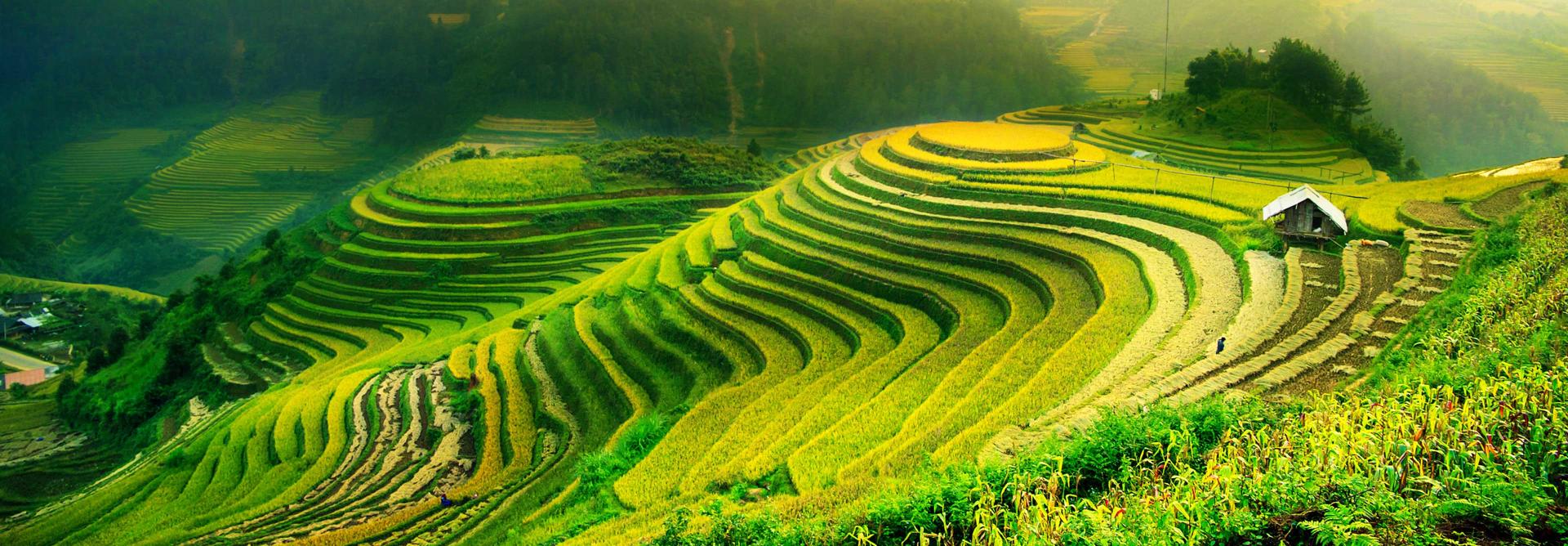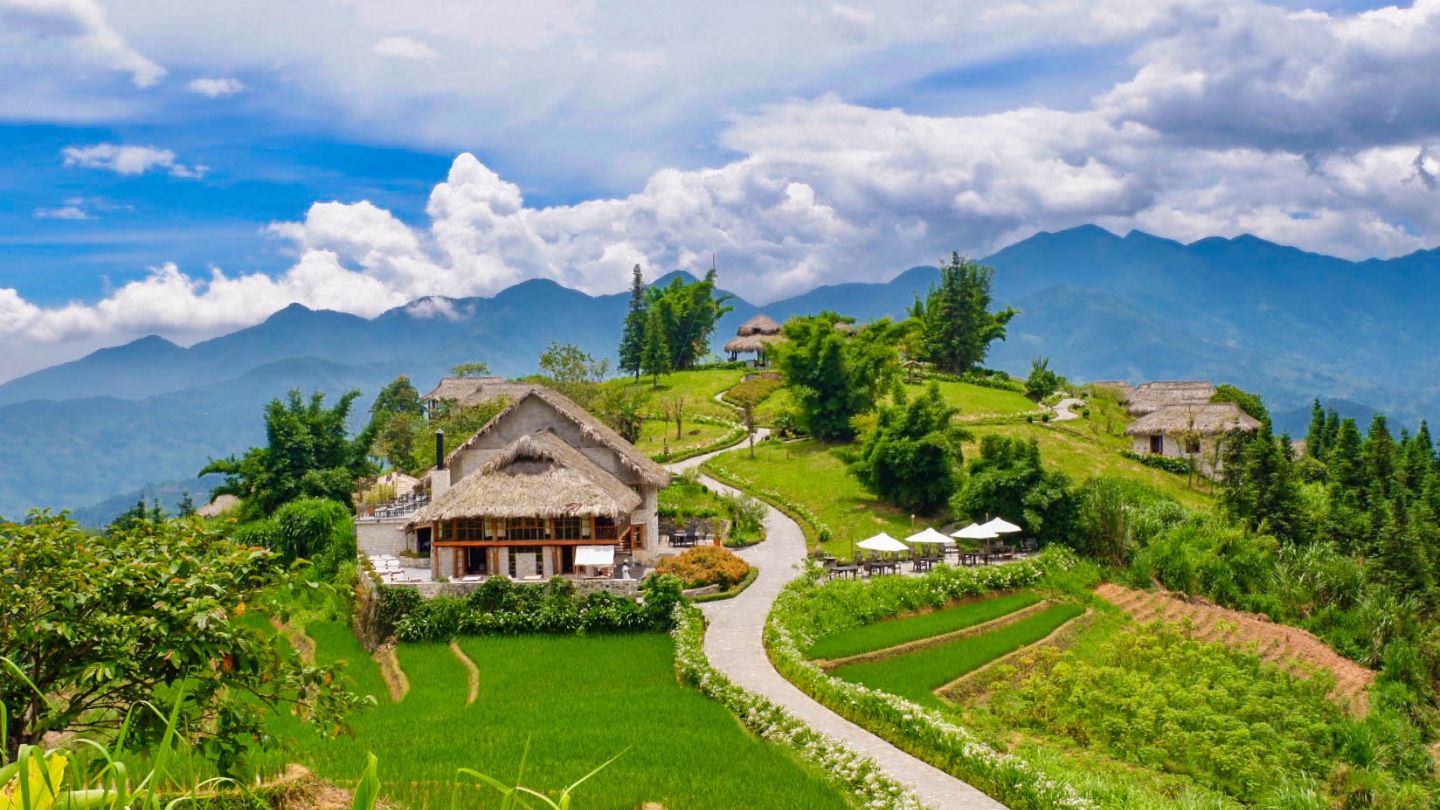



Sapa is a picturesque town in the northwest of Vietnam, located in the Hoàng Liên Son mountain range, known for its dramatic landscapes, terraced rice fields, and rich cultural diversity. It is a popular destination for trekking, cultural exploration, and enjoying the natural beauty of Vietnam’s highlands.
The best time to visit Sapa depends on what you’re looking to experience:
March to May (Spring): This is the perfect time to enjoy mild weather, with lush greenery and beautiful terraced rice fields starting to show their vibrant colors.
September to November (Autumn): This period offers cool weather and stunning golden rice terraces ready for harvest, making it a photographer’s paradise.
December to February (Winter): While it can get quite cold and misty, the winter months offer a unique atmosphere, especially if you enjoy fog and mist drifting over the mountains. Sapa can occasionally experience snow during this period.
Avoid the rainy season (June to August), as it can make trekking difficult and lead to landslides.
Sapa is about 350 kilometers (220 miles) from Hanoi and can be accessed by train, bus, or car.
By Train:
The most popular way to get to Sapa is by taking a night train from Hanoi to Lao Cai Station (about 8 hours), followed by a 1-hour drive from Lao Cai to Sapa by bus or taxi.
By Bus:
Several sleeping buses and limousine buses operate from Hanoi to Sapa, with travel times of around 5-6 hours. This is a convenient option for those who prefer a direct route.
By Car:
Renting a private car or taking a taxi from Hanoi to Sapa is a more expensive but comfortable option, with the trip taking approximately 5-6 hours.
By Motorbike:
For an adventurous route, you can rent a motorbike in Hanoi and ride to Sapa. It’s a challenging but rewarding journey, especially for those who enjoy exploring scenic routes.
Fansipan Mountain:
Known as the "Roof of Indochina," Fansipan is the highest peak in Vietnam, standing at 3,143 meters (10,312 feet). You can reach the summit either by hiking (which takes 2-3 days) or by taking the Fansipan Cable Car, which offers stunning views of the surrounding mountains.
Muong Hoa Valley:
A beautiful valley filled with terraced rice fields, villages, and incredible landscapes. It is also home to several ethnic minority groups, such as the Hmong, Tay, and Dzao people. You can trek through the valley to visit the villages and see the spectacular views.
Cat Cat Village:
Located just a few kilometers from Sapa, this village is known for its traditional Hmong culture, waterfalls, and scenic views. Visitors can explore the village and learn about the daily life of the Hmong people.
Silver Waterfall:
A stunning waterfall located around 15 km from Sapa. The waterfall is known for its beauty and is a popular spot for hiking and photography.
Love Waterfall:
Situated about 14 km from Sapa, this waterfall is a peaceful and scenic destination surrounded by dense forests. It's a great spot for nature lovers.
Sapa Market:
The market in Sapa is a bustling place where locals, many of whom belong to ethnic minorities, sell their handmade products, traditional clothes, and fresh produce. It’s an excellent place to experience the local culture and buy unique souvenirs.
Lao Chai and Ta Van Villages:
These two villages are famous for their Tay, H’mong, and Dzao ethnic groups. Trekking through these villages will give you a glimpse into the traditional lifestyles of the people in the region.
Trekking:
Sapa is a trekker’s paradise, with numerous trekking routes that take you through villages, rice terraces, and mountain landscapes. You can join guided trekking tours to explore the surrounding valleys, including Muong Hoa Valley and Lao Chai and Ta Van villages.
Visit Ethnic Minority Villages:
The area is home to several ethnic minority groups, including the H’mong, Dzao, Tay, and Giay. You can visit their villages to learn about their customs, traditions, and daily life.
Cable Car to Fansipan:
For a less strenuous way to reach the top of Fansipan Mountain, take the Fansipan cable car, which offers one of the world’s longest cable car rides (6.3 km). The view from the top is mesmerizing, with panoramic views of the mountain range.
Visit Local Markets:
Sapa is known for its colorful local markets, especially on Sundays. You can find a wide range of products, from traditional handicrafts to fresh local produce, and interact with the ethnic minority people.
Photography:
With its lush landscapes, terraced rice fields, and misty mountains, Sapa is a dream destination for photographers. Don’t forget to capture the beautiful scenes and portraits of the local people.
Relax in Sapa’s Hot Springs:
For a relaxing experience, visit the Sapa Hot Springs, located around 15 km from the town center. The hot spring water is believed to have therapeutic properties, perfect for unwinding after a long day of trekking.
Sapa has a wide range of accommodations, from budget hostels to luxury resorts.
Sapa Legend Hotel & Spa:
A luxurious hotel offering beautiful views of the mountains and valleys. It’s known for its top-notch amenities, including a spa and wellness center.
Topas Ecolodge:
Located in the heart of nature, this eco-lodge is a great place for those seeking peace and quiet, with stunning views of the terraced rice fields.
Sapa Horizon Hotel:
A mid-range hotel offering spacious rooms, a restaurant with a view, and a good location for exploring Sapa town.
H'mong Sapa Hotel:
A budget-friendly hotel in Sapa with comfortable rooms and a convenient location for exploring the town and surrounding areas.
Auberge des Neiges:
A charming guesthouse with a cozy atmosphere, ideal for those looking for a homely place to stay in Sapa.
Sapa offers a variety of delicious northern Vietnamese dishes, often influenced by the ethnic minority cultures of the region.
Thang Co:
A traditional H’mong dish made from beef, pork, or buffalo, cooked with a variety of herbs and spices. It’s often served with rice or noodles.
Sapa Grilled Pork:
Pork skewers grilled with herbs and served with sticky rice or rice noodles. It’s a simple but delicious dish that is a local favorite.
Com Lam:
This dish consists of rice cooked in bamboo tubes, often served with grilled pork, chicken, or other meats.
Bánh Cuốn:
A type of steamed rice roll filled with minced pork and mushrooms. It’s often served with herbs, fried shallots, and fish sauce.
Sapa Corner Restaurant:
A cozy restaurant serving traditional Vietnamese and local Sapa dishes. It’s known for its friendly atmosphere and great food.
The Hill Station Signature Restaurant:
Offering a mix of Western and Vietnamese dishes, this restaurant is perfect for a relaxed dinner with beautiful views of Sapa.
Le Gecko:
Known for its fusion of Vietnamese and European dishes, this restaurant offers a fine dining experience in Sapa.
Sapa is home to several ethnic minority groups, each with their own traditions, customs, and unique ways of life. The H’mong, Dzao, Tay, and Giay peoples are the main ethnic groups in the region. Visitors can experience traditional lifestyles in the villages, where locals still wear colorful costumes and practice farming using age-old techniques.
Ethnic Markets: Markets in Sapa, especially on Sundays, are not only places to buy products but also important social events where locals gather, trade goods, and celebrate their cultural heritage.
Trekking and Cultural Exchanges: Many trekking tours offer the chance to interact with ethnic minorities, who are often welcoming and happy to share their culture and customs with travelers.
Sapa is a perfect destination for those looking to experience stunning landscapes, rich cultural diversity, and outdoor adventure.